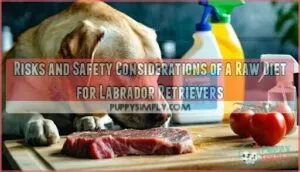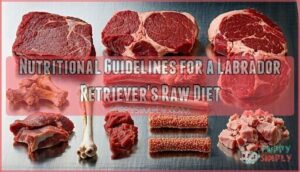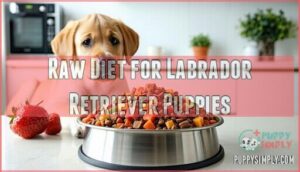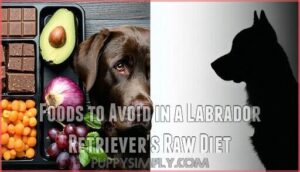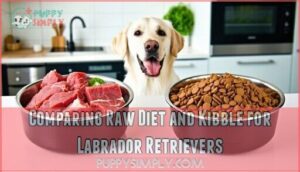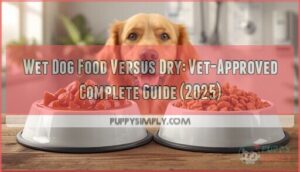This site is supported by our readers. We may earn a commission, at no cost to you, if you purchase through links.

However, you’re walking a tightrope between nutrition and safety.
Raw feeding requires careful attention to bacterial contamination, proper nutrient balance, and safe handling practices.
Your Lab needs specific ratios of muscle meat, organs, and bones to thrive.
While many owners swear by the shinier coats and increased energy they see, improper preparation can lead to serious health issues.
Getting the balance right isn’t rocket science, but there are key details that separate success from disaster.
Table Of Contents
- Key Takeaways
- Benefits of a Raw Diet for Labrador Retrievers
- Risks and Safety Considerations of a Raw Diet for Labrador Retrievers
- Nutritional Guidelines for a Labrador Retriever’s Raw Diet
- Feeding Guidelines for Labrador Retrievers on a Raw Diet
- Raw Diet for Labrador Retriever Puppies
- Cooking, Handling, and Serving Tips for Raw Dog Food
- Transitioning Your Labrador Retriever to a Raw Diet
- Foods to Avoid in a Labrador Retriever’s Raw Diet
- Comparing Raw Diet and Kibble for Labrador Retrievers
- Frequently Asked Questions (FAQs)
- Is raw food good for labradors?
- How much raw food should a Labrador eat?
- What is the best diet for a Labrador?
- Why do vets say not to feed raw?
- How much does raw feeding cost monthly?
- Can senior Labradors switch to raw diet?
- What equipment is needed for raw feeding?
- How long can raw food stay fresh?
- Are there raw diet meal delivery services?
- Conclusion
Key Takeaways
- You’ll see real health benefits – Your Lab can experience cleaner teeth, firmer stools, and a reduced risk of bloat when you switch from kibble to raw food, with many owners noticing improvements within weeks.
- Safety requires vigilance – You must handle raw food carefully, since 10% of products test positive for harmful bacteria, and improper preparation can lead to serious health issues for both you and your Lab.
- Balance is everything – Your Lab needs specific ratios of 70% muscle meat, 10% organs, 10% vegetables, 5% fruit, and 5% green tripe to avoid nutritional deficiencies that could cause stunted growth or organ dysfunction.
- Start slow and get guidance – You should transition gradually over seven days and consult your vet first, as raw feeding costs more upfront and requires dedicated equipment and proper storage techniques.
Benefits of a Raw Diet for Labrador Retrievers
Raw feeding offers compelling health benefits that many Labrador owners find worth considering.
Your Lab may experience cleaner teeth, firmer stools, and reduced bloating when you switch from processed kibble to a biologically appropriate diet.
Dental Benefits of Raw Diet
Raw meaty bones act like nature’s toothbrush for your Labrador.
Raw bones naturally scrub away plaque and tartar buildup while your Lab chews.
The chewing action scrapes away plaque while bone abrasiveness naturally reduces tartar buildup.
This mechanical cleaning stimulates saliva production, which helps maintain healthy gums and fresher breath.
Raw feeding labrador owners often notice cleaner teeth within weeks, making dental health a standout benefit of raw dog food diets, with cleaner teeth being a notable outcome.
Reduced Risk of Bloat
Labradors face higher bloat risk due to their deep chest and enthusiastic eating habits.
Raw feeding helps prevent this dangerous condition by slowing digestion speed and reducing food fermentation in the stomach.
Unlike kibble that expands with moisture, raw food maintains consistent volume, and the improved digestion from raw feeding labrador diets means less gas buildup and fermentation.
Your labrador raw diet creates ideal stomach acidity levels, reducing bloat causes substantially compared to processed foods, and prompt veterinary attention is needed for signs of gastric distress, especially in cases of gastric distress or raw feeding.
Improved Stool Consistency
Beyond preventing bloat, you’ll notice your labrador’s stools become smaller and less smelly on a labrador raw diet.
Raw food benefits include better nutrient absorption, meaning less waste.
The improved digestion comes from natural enzymes that support your dog’s gut microbiome. Higher hydration impact from raw foods aids the digestion rate, while fibers role becomes more effective, creating firmer stools that reflect ideal dog health.
Risks and Safety Considerations of a Raw Diet for Labrador Retrievers
While a raw diet can offer significant benefits for your Labrador, it’s essential to understand the potential risks before making the switch.
Proper knowledge of bacterial contamination, choking hazards, and nutritional balance will help you make an informed decision that keeps your furry friend safe and healthy.
Potential Bacterial Contamination
While raw diets offer benefits, they’re not without serious health concerns.
Raw food safety requires vigilant attention to bacterial contamination. Studies show 10% of canine raw food products test positive for harmful bacteria, while Salmonella and Campylobacter persist even after thorough bowl cleaning.
Raw food safety demands vigilant bacterial contamination monitoring—10% of products test positive for harmful pathogens.
- Your family’s at risk – pathogens from raw dog food can spread to humans through contaminated surfaces
- Antibiotic resistance develops – exposure to resistant bacteria strains threatens both you and your Lab’s health
- Cross-contamination happens fast – one slip in Safe Handling protocols can contaminate your entire kitchen
- Bacterial Sources multiply quickly – improper storage turns fresh ingredients into breeding grounds for dangerous pathogens
Contamination Prevention starts with understanding these risks before implementing raw feeding protocols.
Risk of Intestinal Blockage
Bone fragments pose serious choking hazards and blockage risks for Labradors.
Large breeds face higher breed predisposition to intestinal obstructions from improperly sized pieces.
Bone fragment size matters—smaller shards can lodge in airways or digestive tract.
Your dog’s bone digestion rate varies, making some pieces dangerous.
Watch for distress signs requiring emergency vet care.
Preventative measures include supervising meals and choosing appropriate raw bones for your raw dog food diet.
Importance of Nutrient Balance
Nutritional imbalances can wreak havoc on your Labrador’s health if you don’t carefully plan their raw diet.
Without proper macronutrient ratios and complete proteins from quality organ meat, your dog faces serious deficiencies.
Consider these potential consequences:
- Stunted growth in puppies from inadequate bone content
- Weakened immunity without balanced minerals and vitamin adequacy
- Metabolic disorders from poor micronutrient sources
- Organ dysfunction compromising your Labrador’s long-term health
Nutritional Guidelines for a Labrador Retriever’s Raw Diet
Getting the right nutrition balance is essential when feeding your Labrador a raw diet.
You’ll need to understand the proper ratios of meat, organs, bones, and supplements to keep your dog healthy and thriving.
Nutritional Breakdown for BARF Diet
Getting your BARF diet proportions right creates the foundation for your Labrador’s peak health.
The magic happens when you balance these five key components:
- 70% muscle meat and raw meaty bones – provides essential protein and calcium
- 10% organ meat – liver, heart, and kidney act as nature’s multivitamin
- 10% vegetables – pureed greens improve vegetable digestibility and add fiber
- 5% fruit inclusion – offers antioxidants and natural enzymes
- 5% green tripe – delivers tripe benefits through pre-digested nutrients
These BARF ratios guarantee nutritional balance without requiring supplement alternatives.
Your raw meat diet should maintain proper bone content while supporting your Lab’s energy needs through quality organ meat sources.
Raw Diet Supplements for Labrador Retrievers
While proper nutrition ratios form your foundation, targeted supplements can fill gaps that even well-planned raw diets might miss.
Your Labrador Retriever benefits from strategic supplementation to support peak health on their raw feeding journey.
Consider these key raw diet supplements for your dog’s wellbeing:
- Vitamin E – Protects skin and boosts immune function at 2-4 IU per kilogram daily
- Omega-3s from fish oil – Reduces joint stiffness and inflammation while improving coat quality
- Probiotics – Supports digestive health and improves stool consistency in raw-fed dogs
- Digestive Enzymes – Enhances nutrient absorption from bone and organ components.
These dog health supplements address common nutritional gaps in homemade raw diets, providing joint support and overall wellness your Labrador needs.
Many owners purchase Vitamin E specifically formulated for canines.
Feeding Guidelines for Labrador Retrievers on a Raw Diet
Master the art of portioning raw food for your Labrador Retriever by following these essential feeding guidelines. Adult Labs need 2-3% of their body weight daily, split into two meals, while activity levels and breed specifics influence exact amounts.
| Dog Weight | Daily Amount | Per Meal |
|---|---|---|
| 55 lbs | 1.1-1.65 lbs | 0.55-0.83 lbs |
| 70 lbs | 1.4-2.1 lbs | 0.7-1.05 lbs |
| 85 lbs | 1.7-2.55 lbs | 0.85-1.28 lbs |
Weight monitoring becomes vital when raw feeding your Labrador since they’re prone to overeating. Check their body condition weekly and adjust portions accordingly. Active dogs need more food than couch potatoes, so tailor amounts to your Lab’s lifestyle.
Hydration needs increase with raw food diets due to higher protein content. Make certain fresh water stays available at all times. This raw feeding guide works for most Labs, but pregnant females and senior dogs may need modifications. Start with these portions and fine-tune based on your dog’s response. Remember to keep in mind natural unprocessed ingredients for healthy results.
Raw Diet for Labrador Retriever Puppies
Feeding your Labrador puppy a raw diet requires careful planning to support healthy puppy growth and bone development.
Raw-fed puppies need 5-10% of their body weight daily due to higher calorie needs during rapid development. The weaning process should introduce muscle meat gradually, while organ meats provide immune support through essential vitamins.
Key considerations for raw diet for Labrador puppies:
- Nutritional balance: Provide 50% muscle meat, 20% organ meat, 15% raw bones, and 15% fruits/vegetables to meet puppy nutrition requirements during critical growth phases.
Raw feeding guide emphasizes proper calcium-phosphorus ratios to prevent developmental issues. You can find options for pre-made raw meals online.
Raw food recipes should include variety while maintaining consistent proportions. Monitor your puppy’s energy levels and digestive health throughout this important developmental stage.
Cooking, Handling, and Serving Tips for Raw Dog Food
Before starting any raw food preparation, remember that cleanliness isn’t just recommended—it’s your dog’s lifeline. Proper Hygiene Practices form the foundation of safe raw dog food recipes and homemade dog food preparation.
Key Safety Protocol:
- Temperature Control Chain: Keep raw meat at 32-38°F during preparation, use separate cutting boards for dog food preparation, and wash hands thoroughly between handling sessions.
Safe Thawing requires refrigerator defrosting—never counter-top thawing where bacteria multiply rapidly. For Portioning Strategies, divide meals into single servings before Freezing Techniques preserve freshness.
Store portions in airtight containers for up to six months. To maintain freshness, consider investing in appropriate food storage. Serving Temperatures should match room temperature—cold food can upset sensitive stomachs.
Use stainless steel bowls that clean easily and resist bacterial growth. Always prepare fresh portions rather than leaving food out, as dog food storage becomes critical for preventing contamination.
Your Labrador’s health depends on these fundamental safety measures during every meal preparation.
Transitioning Your Labrador Retriever to a Raw Diet
Your Labrador’s switch to raw food shouldn’t feel like jumping into cold water—take it slow.
Follow a gradual introduction over seven days, starting with 25% raw food mixed with 75% kibble.
This adjustment timeline helps avoid digestive upset while your dog adjusts.
Monitor stool consistency, energy levels, and appetite daily during digestive monitoring.
If diarrhea or vomiting occurs, slow the process down.
Veterinary consultation before starting confirms your Labrador’s health status supports raw diet ingredients.
A homemade diet can offer tailored nutrition needs for your lab.
Proper food safety during handling prevents contamination risks throughout your shift to raw diet journey.
Foods to Avoid in a Labrador Retriever’s Raw Diet
Protecting your Labrador from toxic ingredients isn’t just about avoiding the obvious dangers—it’s about understanding what lurks in seemingly harmless foods.
When preparing raw meals, you’ll need to steer clear of several dangerous items that could turn a healthy diet into a health crisis.
Here are the top toxic foods to avoid in your Lab’s raw diet:
- Chocolate and xylitol – These contain compounds that can cause seizures, rapid breathing, and even death in dogs
- Onions and garlic – Both destroy red blood cells, leading to anemia and serious health complications
- Grapes and raisins – Even tiny amounts can trigger kidney failure in Labradors
- Avocados – The persin compound causes gastrointestinal upset and potential heart problems
Beyond toxic ingredients, watch for bone fragment dangers from cooked bones, which splinter easily.
Some dogs experience allergic reactions to certain proteins, while nutrient imbalances from improper ratios create long-term health issues.
Safe alternatives include approved raw meaty bones and veterinarian-recommended protein sources that won’t compromise your Lab’s wellbeing.
Comparing Raw Diet and Kibble for Labrador Retrievers
Choosing between raw food and kibble for your Labrador isn’t just about ingredient quality—it’s about finding what works for your lifestyle and your dog’s needs.
| Raw Diet | Kibble |
|---|---|
| Higher upfront costs but potentially lower vet bills due to improved labrador health | Less expensive initially but may increase long-term health expenses |
Raw food offers superior digestibility differences, with 26% fewer constipation cases and firmer stools. Your dog’s palatability factors improve dramatically—most Labs find raw meat irresistible compared to processed dog food.
However, kibble wins on convenience and storage. Bear in mind foodborne illness risks when selecting a raw diet.
Cost analysis shows raw diets require more investment upfront but support better dog nutrition and long-term health outcomes.
Frequently Asked Questions (FAQs)
Is raw food good for labradors?
Here’s the twist: raw food can be a double-edged sword for your Lab.
Studies show it may extend lifespan by 32 months and improve dental health, but bacterial contamination and bone fragment risks demand careful consideration and veterinary guidance.
How much raw food should a Labrador eat?
Adult Labradors need 2-3% of their body weight in raw food daily, split into two meals.
A 70-pound Lab gets about 4-1 pounds daily.
Puppies require 5-10% due to rapid growth.
What is the best diet for a Labrador?
High-quality commercial kibble from reputable brands typically provides the most balanced nutrition for your Labrador, though some owners successfully feed carefully planned raw diets with veterinary guidance.
Why do vets say not to feed raw?
Sarah’s golden retriever nearly died after eating contaminated raw chicken that harbored deadly Salmonella bacteria.
Vets discourage raw feeding because studies show raw dog food contains harmful pathogens like E. coli and Salmonella, risking both pet and family health through bacterial contamination.
How much does raw feeding cost monthly?
Raw feeding costs you about $50-150 monthly for a Labrador, depending on ingredient quality and sourcing. You’ll typically spend 2-3% more than premium kibble, but bulk buying helps reduce expenses.
Can senior Labradors switch to raw diet?
Coincidentally, many senior Labs thrive after switching to raw diets.
You can switch older dogs successfully with veterinary guidance.
Start gradually over several weeks, monitoring digestion and energy levels closely for best results.
What equipment is needed for raw feeding?
You’ll need dedicated freezer space, separate cutting boards, stainless steel bowls, meat grinder (optional), sharp knives, and cleaning supplies. Proper storage containers and thermometer help maintain food safety during preparation.
How long can raw food stay fresh?
Fresh refrigerated raw food lasts 2-3 days, while frozen portions stay good for 6-12 months.
You’ll want to thaw only what you’ll use within that window, keeping everything properly chilled to maintain safety.
Are there raw diet meal delivery services?
Yes, several companies deliver pre-made raw dog food directly to your door.
Popular services include Darwin’s Natural Pet Products, We Feed Raw, and Raw Paws Pet Food, offering convenient frozen meals customized to your dog’s needs.
They provide a range of options, but the key is that these services offer convenient frozen meals.
Conclusion
Like traversing uncharted waters, a labrador raw dog food diet requires careful preparation and commitment.
You’ve got the knowledge to make informed decisions about your Lab’s nutrition.
The benefits—improved dental health, better digestion, and reduced bloat risk—can be significant when you follow proper guidelines.
Remember that balance is everything: appropriate ratios, safe handling, and gradual phases.
Your Lab’s individual needs should guide your choices, not trends or one-size-fits-all approaches, ensuring a tailored approach to their nutrition.

